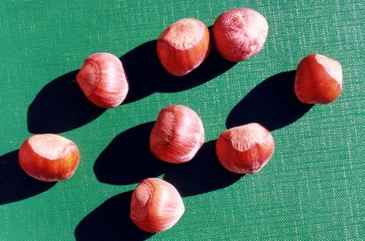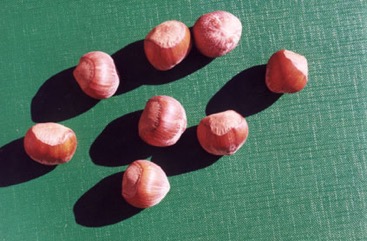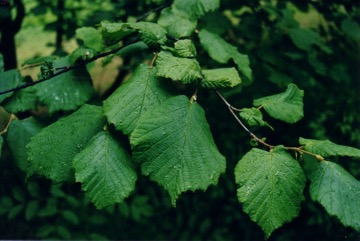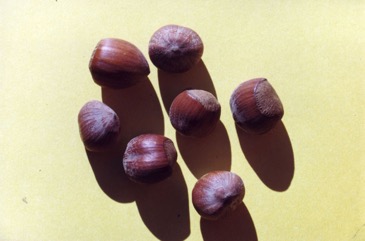Hazel nuts, Cob-nut Hazel, Filberts

A temperate climate plant. They are very frost resistant. They need a certain minimum cold requirement for good production of nuts, so are basically unsuited to the tropics. They need 800-1600 hours of chilling, about the same as apples. They grow in light, well-drained soils, in a protected, partly shaded position. They are drought tender. The flowers can withstand frosts down to -8°C and the wood down to -20°C or -30°C. It suits hardiness zones 4-8. Arboretum Tasmania. Hobart Botanical Gardens.
Also known as:
Aryekh, Aryeshnik, Avellana, Avellano, Basurrek, Bindak, European filbert, European hazelnut, Findak, Findik, Funduk, Leithi, Leska, Lesnik, Lieska, Lijeska, Ljathi, Magyarofa, Mogyorofa, Monyaro, Navadna leska, Nocella, Nocciolo, Oriesky, Oryekh, Pahklipuu, Sarapuu, Tkhili, Urretxa
Synonyms
- Corylus avellana f. aurea (G. Kirchn.) C. K. Schneid.
- Corylus avellana f. contorta (Bean) Rehder
- Corylus avellana f. fusco-rubra Dippel
- Corylus avellana f. heterophylla (Lodd. ex Loudon) Rehder
- Corylus avellana f. pendula (H. Jaeger) Dippel
- Corylus avellana var. aurea G. Kirchn.
- Corylus avellana var. contorta Bean
- Corylus avellana var. fusco-rubra ined.
- Corylus avellana var. heterophylla (Lodd. ex Loudon) Loudon
- Corylus avellana var. pendula H. Jaeger
- Corylus heterophylla Lodd. ex Loudon
Edible Portion
- Nuts, Seeds, Flavouring, Spice, Oil, Flowers, Buds, Leaves
Where does Hazel nuts grow?
Found in: Albania, Armenia, Asia, Australia, Austria, Azerbaijan, Balkans, Belarus, Belgium, Bosnia, Britain, Bulgaria, Canada, Caucasus, Central Asia, China, Czech Republic, Denmark, Estonia, Europe, Finland, France, Georgia, Germany, Greece, Hungary, India, Iran, Iraq, Ireland, Italy, Kazakhstan, Kosovo, Lithuania, Macedonia, Mexico, Netherlands, North Africa, North America, Norway, Pacific, Papua New Guinea, PNG, Poland, Portugal, Romania, Russia, San Marino, Scandinavia, Serbia, Slovakia, Slovenia, Spain, Sweden, Switzerland, Syria, Tasmania, Turkey, Ukraine, United States, Yugoslavia
Notes: There are about 15 Corylus species.
Status: Seeds have been introduced into Papua New Guinea for trial plantings only and are not really a suitable plant for the country.
Growing Hazel nuts, Cob-nut Hazel, Filberts
Cultivation: Plants are grown from seed. Once established, they can be grown from suckers, layering or cuttings. They are often pruned to a single trunk, to make harvesting easier. Trees normally cannot be pollinated from flowers on the same tree. They mostly require cross pollination by wind from suitable pollinator trees. Trees transplant fairly easily. A spacing of 3 m x 3 m is suitable.
Edible Uses: The nuts are eaten. They are also roasted and used in bread, cakes, and confectionary. The seeds are eaten both raw and dried. The kernels have a fatty oil which is edible. The male flowers are eaten. The leaves are used for sarma in Turkey. They are rolled around a filling of rice or minced meat.
Production: Nuts are produced 3-4 years after planting. Layered plants produce nuts in 2-3 years. Yields of 4-6 kg of nuts per tree, are average. Nuts fall when mature. Nuts store well. They should be kept dry and cool.
Nutrition Info
per 100g edible portion| Edible Part | Energy (kcal) | Protein (g) | Iron (mg) | Vitamin A (ug) | Vitamin c (mg) | Zinc (mg) | % Water |
|---|---|---|---|---|---|---|---|
| Seed | 672 | 11.96 | 3.8 | - | 3 | 1.9 | 5.2 |
Hazel nuts, Cob-nut Hazel, Filberts Photos




References
Bianchini, F., Corbetta, F., and Pistoia, M., 1975, Fruits of the Earth. Cassell. p 192
Bodkin, F., 1991, Encyclopedia Botanica. Cornstalk publishing, p 287
Bremness, L., 1994, Herbs. Collins Eyewitness Handbooks. Harper Collins. p 100
Brickell, C. (Ed.), 1999, The Royal Horticultural Society A-Z Encyclopedia of Garden Plants. Convent Garden Books. p 304
Brouk, B., 1975, Plants Consumed by Man. Academic Press, London. p 216
Bussman, R. W., et al, 2016, A comparative ethnobotany of Khevsureti, Samtskhe-Javakheti, Tusheti, Svaneti, and Racha-Lechkhumi, Republic of Georgia (Sakartvelo), Caucasus. Journal of Ethnobiology and Ethnomedicine (2016) 12:4
Bussman, R. W. et al, 2017, Ethnobotany of Samtskhe-Javakheti, Sakartvelo (Republic of Georgia), Caucasus. Indian Journal of Traditional Knowledge Vol. 16(1) pp 7-24
Cerne, M., 1992, Wild Plants from Slovenia used as Vegetables. Acta Horticulturae 318.
Cheifetz, A., (ed), 1999, 500 popular vegetables, herbs, fruits and nuts for Australian Gardeners. Random House p 185
Cundall, P., (ed.), 2004, Gardening Australia: flora: the gardener's bible. ABC Books. p 422
Denes, A., et al, 2012, Wild plants used for food by Hungarian ethnic groups living in the Carpathian Basin. Acta Societatis Botanicorum Poloniae 81 (4): 381-396
Dogan, Y., et al, 2015, Of the importance of a leaf: the ethnobotany of sarma in Turkey and the Balkans. Journal of Ethnobiology and Ethnomedicine, 11:56
Dzhangaliev, A. D., et al, 2003, The Wild Fruit and Nut Plants of Kazakhstan, Horticultural Reviews, Vol. 29. pp 305-371
Ertug, F., 2000, An Ethnobotanical Study in Central Anatolia (Turkey). Economic Botany Vol. 54. No. 2. pp. 155-182
Ertug, F, Yenen Bitkiler. Resimli Türkiye Florası -I- Flora of Turkey - Ethnobotany supplement
Etherington, K., & Imwold, D., (Eds), 2001, Botanica's Trees & Shrubs. The illustrated A-Z of over 8500 trees and shrubs. Random House, Australia. p 232
Facciola, S., 1998, Cornucopia 2: a Source Book of Edible Plants. Kampong Publications, p 82
FAO, 1995, Edible Nuts. Non Wood Forest Products 5.
Farrar, J.L., 1995, Trees of the Northern United States and Canada. Iowa State University press/Ames p 311
Flowerdew, B., 2000, Complete Fruit Book. Kyle Cathie Ltd., London. p 198
French, B.R., 1986, Food Plants of Papua New Guinea, A Compendium. Asia Pacific Science Foundation p 188
Glowinski, L., 1999, The Complete Book of Fruit Growing in Australia. Lothian. p 82
Gouldstone, S., 1983, Growing your own Food-bearing Plants in Australia. Macmillan p 143
Harris, E & J., 1983, Field Guide to the Trees and Shrubs of Britain. Reader's Digest. p 68
Hedrick, U.P., 1919, (Ed.), Sturtevant's edible plants of the world. p 220
http://en.hortipedia.com
Hu, Shiu-ying, 2005, Food Plants of China. The Chinese University Press. p 338
Irving, M., 2009, The Forager Handbook, A Guide to the Edible Plants of Britain. Ebury Press p 64
Jardin, C., 1970, List of Foods Used In Africa, FAO Nutrition Information Document Series No 2.p 33
Joyce, D., 1998, The Garden Plant Selector. Ryland, Peters and Small. p 133
Kalle, R. & Soukand, R., 2012, Historical ethnobotanical review of wild edible plants of Estonia (1770s-1960s) Acta Societatis Botanicorum Poloniae 81(4):271-281
Kargioglu, M., et al, 2008, An Ethnobotanical Survey of Inner-West Anatolia, Turkey. Human Ecology 36:763-777
Kiple, K.F. & Ornelas, K.C., (eds), 2000, The Cambridge World History of Food. CUP p 433, 1784
Kremer, B.P., 1995, Shrubs in the Wild and in Gardens. Barrons. p 164
Lazarides, M. & Hince, B., 1993, Handbook of Economic Plants of Australia, CSIRO. p 65
Lord, E.E., & Willis, J.H., 1999, Shrubs and Trees for Australian gardens. Lothian. p 218
Luczaj, L., 2012, Ethnobotanical review of wild edible plants of Slovakia. Acta Societatis Botanicorum Poloniae 81(4):245-255
Łukasz Łuczaj and Wojciech M Szymański, 2007, Wild vascular plants gathered for consumption in the Polish countryside: a review. J Ethnobiol Ethnomedicine. 3: 17
Łuczaj, L., et al, 2013, Wild edible plants of Belarus: from Rostafiński’s questionnaire of 1883 to the present. Journal of Ethnobiology and Ethnomedicine 2013, 9:21
Luczaj, L., et al, 2015, Wild food plants and fungi used by Ukrainians in the western part of the Maramureş region in Romania. Acta Soc Bot Pol 84(3):339–346
Mabey, R., 1973, Food for Free. A Guide to the edible wild plants of Britain, Collins. p 29
Menendez-Baceta, G., et al, 2012, Wild edible plants traditionally gathered in Gorbeialdea (Biscay, Basque Country) Genetic Reources and Crop Evolution 59:1329-1347
Menninger, E.A., 1977, Edible Nuts of the World. Horticultural Books. Florida p 12
Michael, P., 2007, Edible Wild Plants and Herbs. Grub Street. London. p 117
Mulherin, J., 1994, Spices and natural flavourings. Tiger Books, London. p 110
Nedelcheva A., 2013, An ethnobotanical study of wild edible plants in Bulgaria. EurAsian Journal of BioSciences 7, 77-94
Pieroni, A., 1999, Gathered wild food plants in the Upper Valley of the Serchio River (Garfagnana), Central Italy. Economic Botany 53(3) pp 327-341
Pieroni, A., et al, 2005, Food for two seasons: Culinary uses of non-cultivated local vegetables and mushrooms in a south Italian village. International Journal of Food Sciences and Nutrition, 56(4): 245-272
Pieroni, A., 2008, Local plant resources in the ethnobotany of Theth, a village in the Northern Albanian Alps. Genet Resour Crop Evol (2008) 55:1197–1214
Pieroni, A., et al, 2012, "We are Italians!": The Hybrid Ethnobotany of a Venetian Diaspora in Eastern Romania. Human Ecology 40:435-451
Pieroni, A. et al, 2013, One century later: the folk botanical knowledge of the last remaining Albanians of the upper Reka Valley, Mount Korab, Western Macedonia. Journal of Ethnobiology and Ethnomedicine. 9:22
Pieroni, A., 2017, Traditional uses of wild food plants, medicinal plants, and domestic remedies in Albanian, Aromanian and Macedonian villages in South-Eastern Albania. Journal of Herbal Medicine Volume 9, September 2017, Pages 81-90
Pieroni, A. & Soukand, R., 2018, Forest as Stronghold of Local Ecological Practice: Currently Used Wild Food Plants in Polesia, Northern Ukraine. Economic Botany, XX(X) pp. 1-21
Plants for a Future, The Field, Penpol, Lostwithiel, Cornwall, PL22 0NG, UK. http://www.scs.leeds.ac.uk/pfaf/
Postman, J. D., et al, 2012, Recent NPGS Coordinated Expeditions in the Trans-Caucasus Region to Collect Wild Relatives of Temperate Fruit and Nut Crops. In Acta Horticulturae Number 948 p 191-198
Redzic, S. J., 2006, Wild Edible Plants and their Traditional Use in the Human Nutrition in Bosnia-Herzegovina. Ecology of Food and Nutrition, 45:189-232
Sansanelli, S., et al, 2014, Wild food plants traditionall consumed in the area of Bologna (Emilia Romagna region, Italy). Journal of Ethnobiology and Ethnomedicine 10:69
Segura, S. et al, 2018, The edible fruit species in Mexico. Genet Resour Crop Evol (2018) 65:1767–1793
Sfikas, G., 1984, Trees and shrubs of Greece. Efstathiadis Group. Athens. p 134
Simkova, K. et al, 2014, Ethnobotanical review of wild edible plants used in the Czech Republic. Journal of Applied Botany and Food Quality 88, 49-67
Small, E., 2009, Top 100 Food Plants. The world's most important culinary crops. NRC Research Press. p 264
Smith, P.M., 1979, Hazel, in Simmonds, N.W., (ed), Crop Plant Evolution. Longmans. London. p 305
Soukand, R., et al, 2017, Multi-functionality of the few: current and past uses of wild plants for food and healing in Liubań region, Belarus. Journal of Ethnobiology and Ethnomedicine (2017) 13:10
Sp. pl. 2:998. 1753
Tardio, J., et al, 2006, Ethnobotanical review of wild edible plants in Spain. Botanical J. Linnean Soc. 152, 27-71
USDA, ARS, National Genetic Resources Program. Germplasm Resources Information Network - (GRIN). [Online Database] National Germplasm Resources Laboratory, Beltsville, Maryland. Available: www.ars-grin.gov/cgi-bin/npgs/html/econ.pl (10 April 2000)
van Wyk, B., 2005, Food Plants of the World. An illustrated guide. Timber press. p 153
Wickens, G.E., 1995, Edible Nuts. FAO Non-wood forest products. FAO, Rome. p 18, 118
Wild Edible Plants of the Whitmire Wildflower Garden. Missouri Botanical Gardens.
World Checklist of Useful Plant Species 2020. Royal Botanic Gardens, Kew
Young, J., (Ed.), 2001, Botanica's Pocket Trees and Shrubs. Random House. p 279